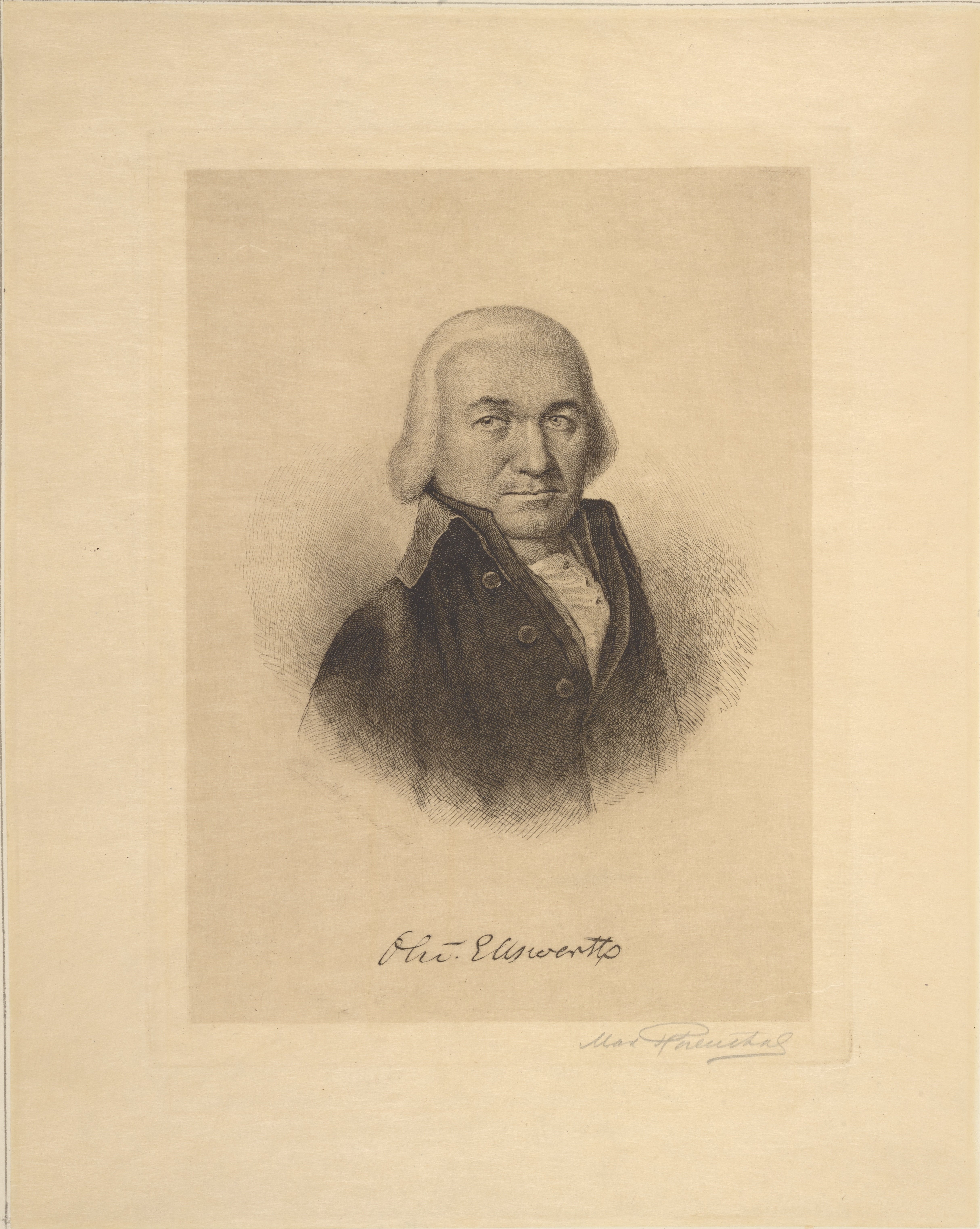Oliver Ellsworth
Oliver Ellsworth (1745-1807) served as the Chief Justice of the United States Supreme Court from 1796 to 1800.
Portrait
Max Rosenthal, Oliv. Ellsworth, n.d., print: etching, United States Supreme Court: Portraits and Autographs, D'Angelo Law Library Rare Book Room, University of Chicago Library.
Signed by the artist, Max Rosenthal.
For more information about the etched portrait of Oliver Ellsworth, see:
- "Oliver Ellsworth," Record, Prints & Photographs Online Catalog, Prints & Photographs Reading Room, Library of Congress, accessed July 22, 2019, https://www.loc.gov/pictures/item/2002714595/.
Signature
Detail from Bank Draft from Oliver Ellsworth to O. Wolcott, April 1797, United States Supreme Court: Portraits and Autographs, D'Angelo Law Library Rare Book Room, University of Chicago Library.
The Document
Bank Draft from Oliver Ellsworth to O. Wolcott, April 1797, United States Supreme Court: Portraits and Autographs, D'Angelo Law Library Rare Book Room, University of Chicago Library.
Transcription of the Bank Draft:
April [?] 1797 -
Cashier of the Bank of the United States,
Pay O. Wolcott or bearer One Thousand Dollars.
1000. Dollars
Oliv. Ellsworth
About this Document
About the Bank of the United States
At the time that Oliver Ellsworth wrote this bank draft, he was serving as Chief Justice of the United States Supreme Court (the seat that had been vacated by John Rutledge). He wrote that the draft was on "the Bank of the United States," which is now referred to as the First Bank of the United States. The First Bank of the United States, proposed by then Secretary of the Treasury Alexander Hamilton, was chartered by the United States Congress in 1791 and was located in Philadelphia, Pennsylvania. The charter for the bank expired in 1811, and in 1816 Congress chartered the Second Bank of the United States.
For more about the First Bank of the United States, see:
- Follow this link to search the University of Chicago Library catalog for the subject heading "Bank of the United States (1791-1811)".
About O. Wolcott
At the time that Oliver Ellsworth wrote this bank draft, there were two possible O. Wolcotts to whom this draft could have been sent:
- Oliver Wolcott Sr., who was then serving as the Lieutenant Governor of Connecticut and had been a signer of the Declaration of Independence; or
- His son Oliver Wolcott Jr., who was then serving as the second Secretary of the Treasury (after Alexander Hamilton) and would later serve as a United States Circuit Judge and the Governor of Connecticut.
Both men were relatives of Ellsworth's wife, Abigail Wolcott Ellsworth.
For more about Oliver Wolcott Sr. and Oliver Wolcott Jr., see:
- "A Guide to the Oliver Wolcott, Sr. Papers at the Connecticut Historical Society," Connecticut Historical Society, accessed July 12, 2019, https://chs.org/finding_aides/finding_aids/wolco1797.html.
- "Declaration of Independence: A Transcription" America's Founding Documents, U.S. National Archives and Records Administration, accessed July 12, 2019, https://www.archives.gov/founding-docs/declaration-transcript.
- George Gibbs, Memoirs of the Administrations of Washington and John Adams, ed. from the Papers of Oliver Wolcott, Secretary of the Treasury (New York: Printed for the Subscribers, W. Van Norden, Printer, 1846).
- Oliver Wolcott, An address, to the people of the United States, on the subject of the report of a committee of the House of Representatives, appointed to "examine and report, whether monies drawn from the Treasury, have been faithfully applied to the objects for which they were appropriated, and whether the same have been regularly accounted for," which report was presented on the 29th of April, 1802 (Boston: Russell and Cutler, 1802).
- Oliver Wolcott, Remarks on the Present State of Currency, Credit, Commerce, and National Industry: In Reply to an Address of the Tammany Society of New York (New York: C. Wiley & Co., 1820).
- Linda Hocking, "Wolcott family collection, 1740-1844," Litchfield Historical Society, accessed July 12, 2019, https://www.litchfieldhistoricalsociety.org/archon/?p=collections/findingaid&id=5&q=.
About Oliver Ellsworth
Oliver Ellsworth began his career as a lawyer in private practice in Connecticut. He was involved in Connecticut politics, and served as a delegate to the Continental Congress and delegate to the Federal Constitutional Convention. He also served as a U.S. Senator from Connecticut.
Oliver Ellsworth was nominated by George Washington to serve as Chief Justice of the Unites States Supreme Court in 1796 and he served in that role until his resignation in 1800. While serving as Chief Justice, Ellsworth also served as a minister plenipotentiary to France from 1799-1800.
For more about Oliver Ellsworth's life and career, see:
- Follow this link to search the University of Chicago Library catalog for the subject heading "Ellsworth, Oliver, 1745-1807".
- "Founders Online," National Historical Publications & Records Commission, U.S. National Archives and Records Administration, accessed July 12, 2019, https://founders.archives.gov/.
- Contains letters to and from Oliver Ellsworth in the searchable papers of George Washington, Benjamin Franklin, John Adams, Thomas Jefferson, Alexander Hamilton, and James Madison (administered by the U.S National Archives and Records Administration).
- "Ellsworth, Oliver," Federal Judicial Center, accessed July 12, 2019, https://www.fjc.gov/history/judges/ellsworth-oliver.
- Lists background information on his professional career as well as a bibliography and list of manuscript collections.
- " ELLSWORTH, Oliver (1745-1807)," Guide to Research Collections, Biographical Directory of the United States Congress, accessed July 12, 2019, http://bioguide.congress.gov/scripts/guidedisplay.pl?index=E000147.



